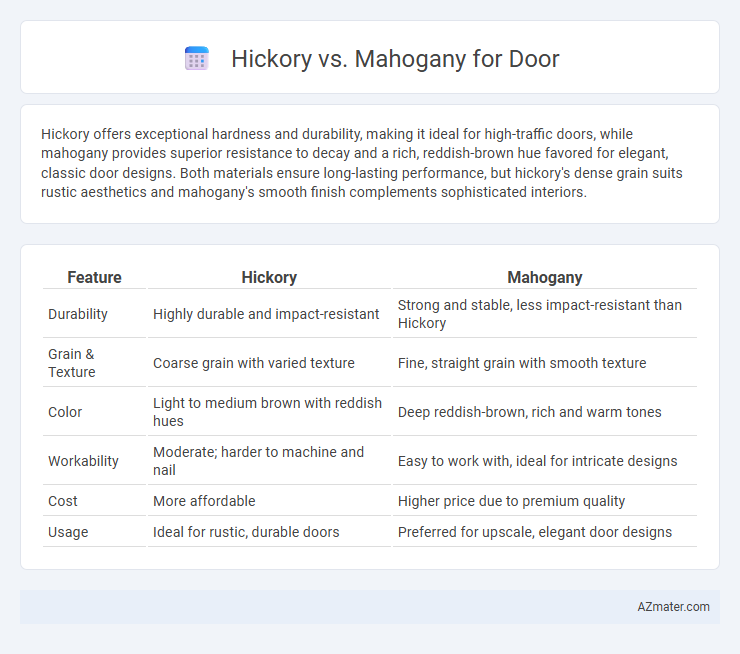Hickory offers exceptional hardness and durability, making it ideal for high-traffic doors, while mahogany provides superior resistance to decay and a rich, reddish-brown hue favored for elegant, classic door designs. Both materials ensure long-lasting performance, but hickory's dense grain suits rustic aesthetics and mahogany's smooth finish complements sophisticated interiors.
Table of Comparison
| Feature | Hickory | Mahogany |
|---|---|---|
| Durability | Highly durable and impact-resistant | Strong and stable, less impact-resistant than Hickory |
| Grain & Texture | Coarse grain with varied texture | Fine, straight grain with smooth texture |
| Color | Light to medium brown with reddish hues | Deep reddish-brown, rich and warm tones |
| Workability | Moderate; harder to machine and nail | Easy to work with, ideal for intricate designs |
| Cost | More affordable | Higher price due to premium quality |
| Usage | Ideal for rustic, durable doors | Preferred for upscale, elegant door designs |
Introduction to Hickory and Mahogany Doors
Hickory doors are prized for their exceptional hardness, distinctive grain patterns, and durability, making them ideal for high-traffic areas requiring robust performance. Mahogany doors offer a rich, deep reddish-brown hue with a smooth texture and natural resistance to rot and insects, favored for elegant and classic architectural styles. Both woods provide excellent stability and longevity, but Hickory emphasizes strength and rustic appeal, while Mahogany highlights refined aesthetics and premium quality for door applications.
Key Differences Between Hickory and Mahogany
Hickory wood is known for its exceptional hardness and durability, making it ideal for doors requiring high resistance to wear and impact, while Mahogany is prized for its rich, deep reddish-brown color and fine, straight grain that enhances aesthetic appeal. Hickory features a more varied grain pattern with color contrasts ranging from creamy white to dark brown, whereas Mahogany offers a consistent texture and smooth finish, often preferred for elegant or traditional door designs. In terms of cost and workability, Hickory tends to be more affordable but challenging to machine due to its density, whereas Mahogany is easier to carve and shape, justifying its higher price in premium door applications.
Durability and Strength Comparison
Hickory doors offer exceptional durability with a Janka hardness rating of 1,820, making them highly resistant to dents and wear from everyday use. Mahogany, with a slightly lower Janka hardness of approximately 1,210, provides strong resistance to moisture and decay, enhancing its longevity in humid environments. Both hardwoods deliver robust strength for door construction, but hickory surpasses mahogany in hardness, while mahogany excels in natural resistance to rot.
Aesthetic Appeal: Grain and Color Variations
Hickory doors showcase a striking aesthetic appeal with their bold, contrasting grain patterns and a wide spectrum of natural colors ranging from creamy whites to rich browns, creating a rustic yet dynamic look. Mahogany doors offer a more uniform and refined appearance, characterized by a deep reddish-brown hue and a smooth, straight grain that exudes classic elegance and warmth. Both woods provide unique visual textures that enhance door designs, with hickory lending a distinctive, varied pattern and mahogany delivering consistent richness and sophistication.
Maintenance Requirements for Each Wood Type
Hickory doors demand regular sealing and polishing to prevent moisture absorption and maintain their rich grain pattern, making maintenance moderately frequent. Mahogany doors require less frequent upkeep due to their natural resistance to rot and insects, typically needing only periodic cleaning and occasional re-oiling to preserve luster. Both woods benefit from protective finishes, but mahogany's dense grain reduces the need for intensive maintenance compared to hickory.
Cost Analysis: Hickory vs Mahogany
Hickory doors typically cost between $50 and $100 per square foot, offering a balance of durability and affordability compared to mahogany, which ranges from $80 to $150 per square foot due to its premium grain and rich color. Mahogany's higher price reflects its status as a luxury hardwood with superior decay resistance and aesthetic appeal, ideal for upscale architectural designs. Hickory stands out as a cost-effective option with excellent hardness and abrasion resistance, making it suitable for high-traffic door applications where budget constraints are significant.
Environmental Impact and Sustainability
Hickory doors are sourced from fast-growing hardwood trees, making them a more renewable option compared to slower-growing mahogany, which is often harvested from tropical rainforests with higher ecological sensitivity. Mahogany's extraction can contribute to deforestation and habitat loss, whereas hickory's widespread availability reduces pressure on endangered forests. Choosing hickory supports sustainable forestry practices and lowers environmental impact, offering an eco-friendly alternative for door construction.
Best Applications for Hickory and Mahogany Doors
Hickory doors excel in high-traffic areas due to their exceptional hardness and resistance to dents, making them ideal for entryways and commercial settings requiring durable materials. Mahogany doors are preferred for luxury interiors and exterior applications where rich color, fine grain, and superior weather resistance enhance aesthetics and long-term performance. Both woods offer strong security features, but Hickory's toughness suits rustic or farmhouse styles, while Mahogany complements traditional and elegant architectural designs.
Pros and Cons of Hickory Doors
Hickory doors offer exceptional durability and resistance to wear, making them ideal for high-traffic areas and enhancing home security. Their unique grain pattern and warm tones provide a rustic, natural aesthetic but can be more difficult to stain evenly compared to mahogany. Hickory is generally harder and heavier than mahogany, which can increase installation complexity and may require more maintenance over time.
Pros and Cons of Mahogany Doors
Mahogany doors offer exceptional durability and rich, deep reddish-brown tones that enhance aesthetic appeal, making them ideal for high-end, elegant home designs. Their natural resistance to rot and insects ensures long-lasting performance, but the higher cost and potential for fading without proper maintenance can be drawbacks. Mahogany's dense grain provides superior strength and sound insulation compared to Hickory, yet it may require more frequent refinishing to preserve its luxurious appearance.

Infographic: Hickory vs Mahogany for Door
 azmater.com
azmater.com